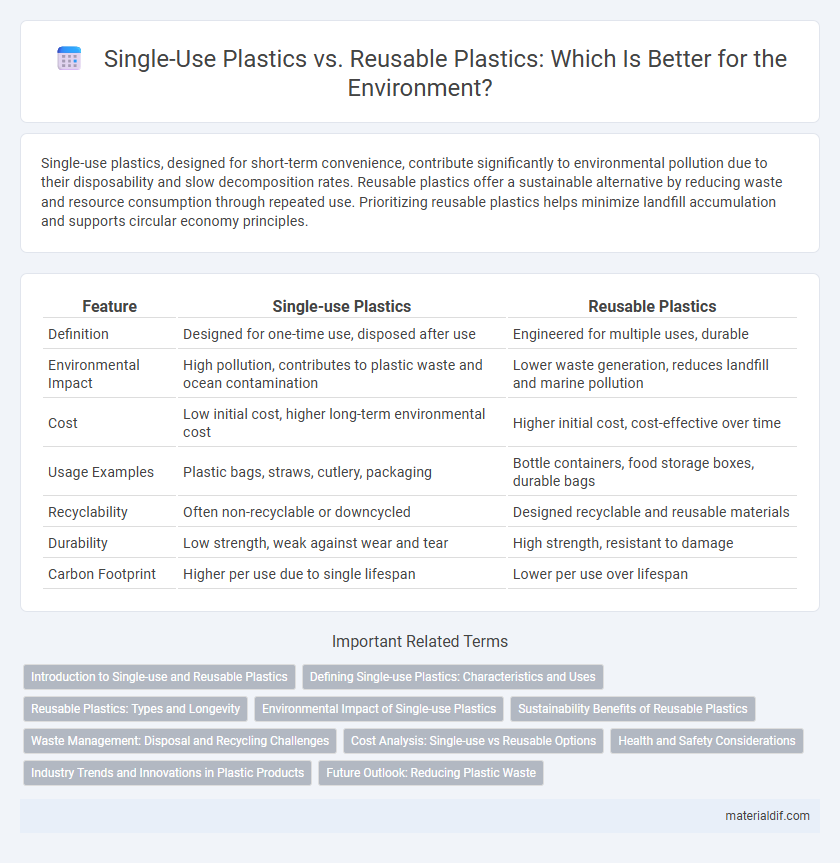Single-use plastics, designed for short-term convenience, contribute significantly to environmental pollution due to their disposability and slow decomposition rates. Reusable plastics offer a sustainable alternative by reducing waste and resource consumption through repeated use. Prioritizing reusable plastics helps minimize landfill accumulation and supports circular economy principles.
Table of Comparison
| Feature | Single-use Plastics | Reusable Plastics |
|---|---|---|
| Definition | Designed for one-time use, disposed after use | Engineered for multiple uses, durable |
| Environmental Impact | High pollution, contributes to plastic waste and ocean contamination | Lower waste generation, reduces landfill and marine pollution |
| Cost | Low initial cost, higher long-term environmental cost | Higher initial cost, cost-effective over time |
| Usage Examples | Plastic bags, straws, cutlery, packaging | Bottle containers, food storage boxes, durable bags |
| Recyclability | Often non-recyclable or downcycled | Designed recyclable and reusable materials |
| Durability | Low strength, weak against wear and tear | High strength, resistant to damage |
| Carbon Footprint | Higher per use due to single lifespan | Lower per use over lifespan |
Introduction to Single-use and Reusable Plastics
Single-use plastics are designed for one-time use before disposal, commonly found in items such as plastic bags, straws, and food packaging. Reusable plastics, made from more durable materials like polypropylene or polyethylene terephthalate, offer multiple usage cycles, reducing waste and environmental impact. Choosing reusable plastics significantly decreases plastic pollution, contributing to sustainable waste management and conservation efforts.
Defining Single-use Plastics: Characteristics and Uses
Single-use plastics are designed for one-time use before disposal, characterized by lightweight, low-cost materials such as polyethylene, polypropylene, and polystyrene. Common applications include packaging films, disposable cutlery, straws, and food containers, which prioritize convenience and hygiene. Despite their practicality, single-use plastics contribute significantly to environmental pollution due to their persistent nature and limited recyclability.
Reusable Plastics: Types and Longevity
Reusable plastics include high-density polyethylene (HDPE), polypropylene (PP), and polyethylene terephthalate (PET), known for their durability and resistance to wear. These materials can withstand repeated washing and prolonged use, extending their lifespan from months to several years compared to single-use plastics. Proper use and maintenance of reusable plastics significantly reduce environmental impact by minimizing plastic waste and resource consumption.
Environmental Impact of Single-use Plastics
Single-use plastics significantly contribute to environmental pollution due to their limited decomposition rates, often persisting for hundreds of years in landfills and oceans. These plastics release harmful microplastics and toxic chemicals that disrupt marine ecosystems and pose risks to human health through the food chain. Reducing reliance on single-use plastics in favor of reusable alternatives is crucial for minimizing ecological damage and conserving biodiversity.
Sustainability Benefits of Reusable Plastics
Reusable plastics significantly reduce environmental impact by minimizing plastic waste and lowering resource consumption compared to single-use plastics. These durable materials enable multiple usage cycles, decreasing the demand for raw materials and energy involved in production. By promoting reuse, they contribute to conservation efforts and reduce greenhouse gas emissions associated with plastic disposal and manufacturing.
Waste Management: Disposal and Recycling Challenges
Single-use plastics generate significant waste due to their short lifespan and lack of efficient recycling infrastructure, contributing to landfill overflow and environmental pollution. Reusable plastics, while reducing waste volume, still pose recycling challenges because of material contamination and mixed polymer compositions. Effective waste management requires advanced sorting technologies and public awareness to improve recycling rates and minimize the ecological impact of both single-use and reusable plastics.
Cost Analysis: Single-use vs Reusable Options
Single-use plastics typically have lower upfront costs but result in higher long-term expenses due to frequent replacements and environmental impact fees. Reusable plastics involve higher initial investments but offer cost benefits over time through durability and reduced waste management costs. Evaluating lifecycle costs highlights that reusable plastics provide better economic value combined with sustainability advantages.
Health and Safety Considerations
Single-use plastics often contain additives like phthalates and BPA, which can leach into food or beverages and pose health risks such as hormonal disruptions. Reusable plastics made from food-grade materials are designed to minimize chemical migration, but require proper cleaning to prevent microbial contamination. Choosing BPA-free, phthalate-free reusable plastics and maintaining hygienic practices significantly enhance safety for consumers.
Industry Trends and Innovations in Plastic Products
The plastic industry is rapidly shifting towards reusable plastics due to growing environmental concerns and regulatory pressures targeting single-use plastics. Innovations such as biodegradable polymers, advanced recycling technologies, and durable design improvements are driving the development of sustainable plastic products. Market demand favors reusable options in packaging, food service, and consumer goods, boosting investments in circular economy models and closed-loop recycling systems.
Future Outlook: Reducing Plastic Waste
Single-use plastics contribute significantly to global waste, with an estimated 300 million tons produced annually, overwhelming landfills and oceans. Reusable plastics offer a sustainable alternative by lowering demand for disposable items, potentially reducing plastic pollution by up to 80% over the next decade. Advances in biodegradable materials and increased recycling infrastructure are critical to enhancing the environmental benefits of reusable plastics and achieving long-term waste reduction goals.
Single-use Plastics vs Reusable Plastics Infographic

 materialdif.com
materialdif.com